To harmonize bold tea flavors in blends, you'll want to focus on complementary ingredients and techniques. Start by pairing strong teas with milder varieties to create balance. Add herbs and spices that enhance the tea's profile, like warming cinnamon or floral chrysanthemum. Citrus notes can brighten and cut through richness, while sweeteners can amplify existing flavors. Don't forget about temperature and steeping time—adjust these to bring out desired characteristics without overpowering. Layering ingredients carefully will build complexity and depth in your blend. By mastering these elements, you'll reveal the secret to creating perfectly harmonized bold tea blends.
Understanding Bold Tea Flavors

Bold tea flavors are characterized by their intense and robust profiles that leave a lasting impression on the palate. These flavors typically come from teas like Assam, Yunnan black, or Lapsang Souchong, known for their strong, full-bodied taste. When you encounter bold teas, you'll notice they often have a deep color and a powerful aroma that hints at their strength.
To understand bold tea flavors, you'll need to pay attention to their unique characteristics. They may exhibit malty, smoky, or earthy notes, sometimes with a slight astringency that creates a satisfying mouthfeel. Bold teas often have higher tannin content, which contributes to their assertive nature and can sometimes result in a slightly bitter aftertaste.
It's important to recognize that boldness in tea isn't just about strength. It's about complexity and depth of flavor. These teas can have layers of taste that unfold as you sip, revealing nuances like cocoa, leather, or even tobacco.
Understanding these flavors is vital when considering how to harmonize them in blends, as their potent nature can easily overpower more delicate ingredients if not balanced properly.
Complementary Herbs and Spices
When it comes to harmonizing bold tea flavors, complementary herbs and spices play an essential role. They can enhance, balance, or contrast the dominant notes in your tea blend, creating a more complex and satisfying taste experience.
For robust black teas, consider adding warming spices like cinnamon, cardamom, or ginger. These complement the tea's natural astringency while adding depth and sweetness.
If you're working with earthy pu-erh teas, try incorporating chrysanthemum or rose petals for a floral counterpoint.
Strong green teas pair well with mint, lemongrass, or jasmine, which can lighten their grassy notes and add invigorating elements.
For bold oolong teas, experiment with fruit additions like dried peach or apricot to soften their intensity and introduce a subtle sweetness.
Don't overlook herbs like lavender, chamomile, or sage, which can mellow out intense flavors and contribute calming properties.
Balancing With Mild Base Teas
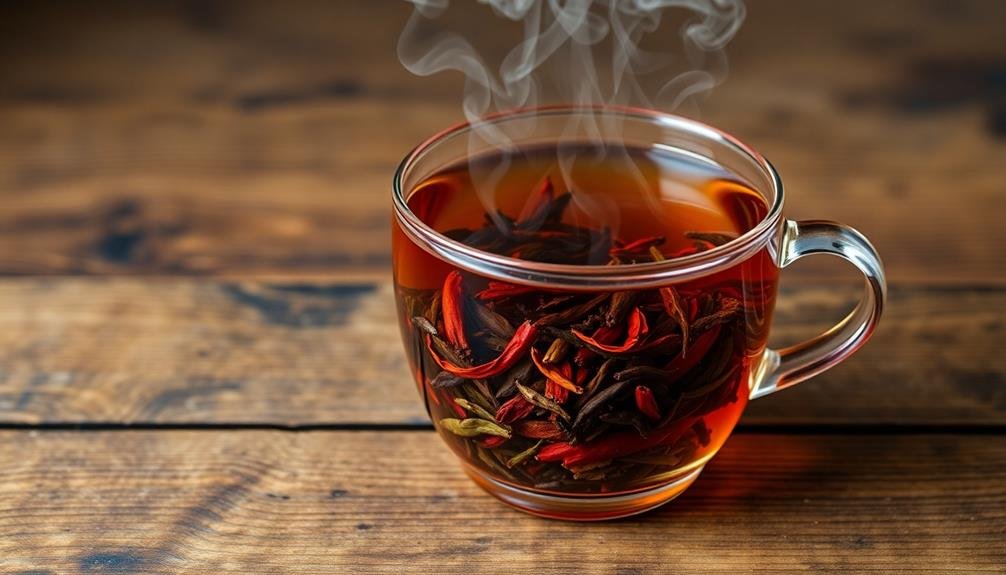
While complementary herbs and spices can enhance bold tea flavors, another effective approach is balancing them with mild base teas. You'll find that using a gentle, neutral tea as a foundation can soften the intensity of bolder varieties, creating a more harmonious blend.
Consider pairing a robust Assam or Lapsang Souchong with a delicate white tea or a mellow green tea like Dragonwell. The milder base will act as a canvas, allowing the bold flavors to shine without overwhelming your palate.
You can also experiment with light oolong teas, which offer a subtle complexity that complements stronger notes.
When blending, start with a higher ratio of the mild base tea and gradually add the bold variety until you achieve the desired balance. This method allows you to control the intensity and create a more nuanced flavor profile.
Don't be afraid to mix different types of mild teas to create a unique base that enhances the bold flavors in unexpected ways.
Citrus Notes for Harmony
To add a bright, invigorating contrast to bold tea flavors, you can't go wrong with citrus notes. These zesty additions can lift and enliven even the most robust teas, creating a harmonious balance that tantalizes your taste buds.
Citrus elements work particularly well with black teas, oolongs, and even some green teas, cutting through richness and adding a rejuvenating dimension to the blend.
When incorporating citrus notes, you've got several options:
- Dried citrus peels (orange, lemon, or bergamot)
- Essential oils (be cautious with amounts)
- Fresh citrus zest (for immediate consumption)
You'll find that citrus can complement earthy, smoky, or malty flavors in bold teas. It's not just about adding a sour note; citrus brings complexity and depth to your blend.
The key is to start with small amounts and adjust to taste. You're aiming for a subtle enhancement, not overpowering the tea's natural characteristics.
Experiment with different citrus fruits to find your perfect pairing. Lemon might work wonders with an Assam, while bergamot could be the ideal match for a robust Yunnan black tea.
Sweeteners as Flavor Enhancers
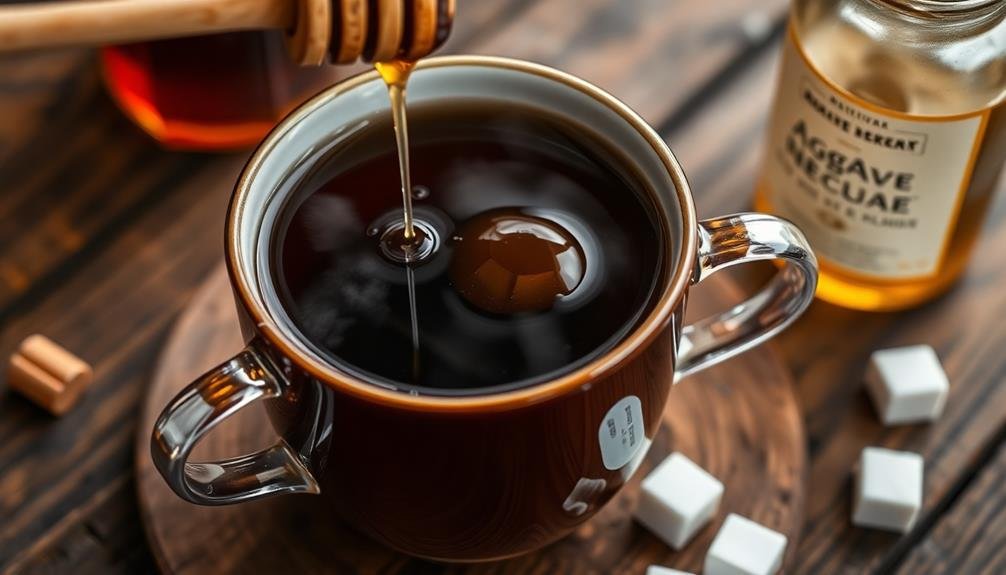
When selecting sweeteners for your bold tea, you'll find both natural and artificial options available.
You'll need to strike a balance between enhancing sweetness and preserving the tea's inherent bitterness.
Consider sweeteners with complementary flavor profiles that'll elevate your tea's overall taste experience.
Natural vs. Artificial Options
Although sweeteners can enhance tea flavors, choosing between natural and artificial options isn't always straightforward.
Natural sweeteners like honey, agave nectar, and stevia offer distinct flavors that can complement certain teas. Honey, for instance, pairs well with bold black teas, while agave's mild sweetness works nicely with delicate green teas. Stevia, a zero-calorie option, can balance out bitter notes in some blends.
Artificial sweeteners, on the other hand, provide sweetness without added calories. They're often preferred by those watching their sugar intake. However, some artificial options may leave an aftertaste that clashes with the tea's natural flavors.
When selecting a sweetener for your tea, consider:
- The tea's inherent flavor profile
- Your dietary preferences and restrictions
- The sweetener's potential impact on the tea's overall taste
Ultimately, the choice between natural and artificial sweeteners comes down to personal preference and health considerations.
You might find that different sweeteners work best with various tea blends, so don't hesitate to experiment. Remember, the goal is to enhance, not overpower, the tea's bold flavors.
Balancing Sweetness and Bitterness
The art of balancing sweetness and bitterness in tea is vital for creating a harmonious flavor profile. When you're crafting bold tea blends, you'll need to carefully consider how to achieve this balance. Sweeteners can play an important role in enhancing and complementing the natural flavors of your tea.
You'll find that different sweeteners can dramatically alter the taste of your blend. Honey, for instance, adds a complex sweetness that pairs well with robust black teas. If you're working with green or white teas, you might opt for a lighter sweetener like agave nectar or stevia. These won't overpower the delicate notes of the tea.
For those who prefer a less sweet option, consider using fruit pieces or herbs to add natural sweetness. Dried berries or citrus peels can provide a subtle sweetness while enhancing the tea's overall flavor profile.
You can also experiment with spices like cinnamon or licorice root, which offer natural sweetness without added sugars.
Complementary Flavor Profiles
Beyond balancing sweetness and bitterness, sweeteners can act as powerful flavor enhancers in bold tea blends. They can amplify existing notes and introduce new dimensions to your tea's profile. When selecting sweeteners, consider how they'll interact with your tea's inherent flavors.
Honey, for instance, pairs excellently with bold black teas, enhancing their malty notes and adding a floral complexity. Maple syrup complements the smoky qualities of Lapsang Souchong, while agave nectar can brighten citrusy notes in Earl Grey.
For a sophisticated approach to sweetening, try these options:
- Date syrup: Adds caramel-like depth to robust Assam teas
- Coconut sugar: Enhances the nutty undertones in oolong blends
- Stevia leaves: Provides sweetness without overpowering delicate green teas
Temperature and Steeping Time
In accordance with the art of brewing bold teas, temperature and steeping time play crucial roles. These factors greatly influence the extraction of flavors and the overall taste profile of your blend.
For robust black teas, you'll want to use water that's just off the boil, around 95-100°C (203-212°F). This high temperature helps extract the full-bodied flavors and tannins that give black teas their characteristic boldness.
Steeping time for bold teas typically ranges from 3 to 5 minutes. You'll need to experiment to find the perfect balance, as over-steeping can result in bitterness.
For oolong teas, which are often included in bold blends, slightly lower temperatures of 85-95°C (185-203°F) and shorter steeping times of 2-3 minutes are ideal. This approach preserves the tea's complex flavors without overwhelming bitterness.
When creating bold tea blends, consider how different components react to temperature and steeping time. Adjust these parameters to highlight desired flavors and achieve harmony.
Layering Ingredients for Complexity
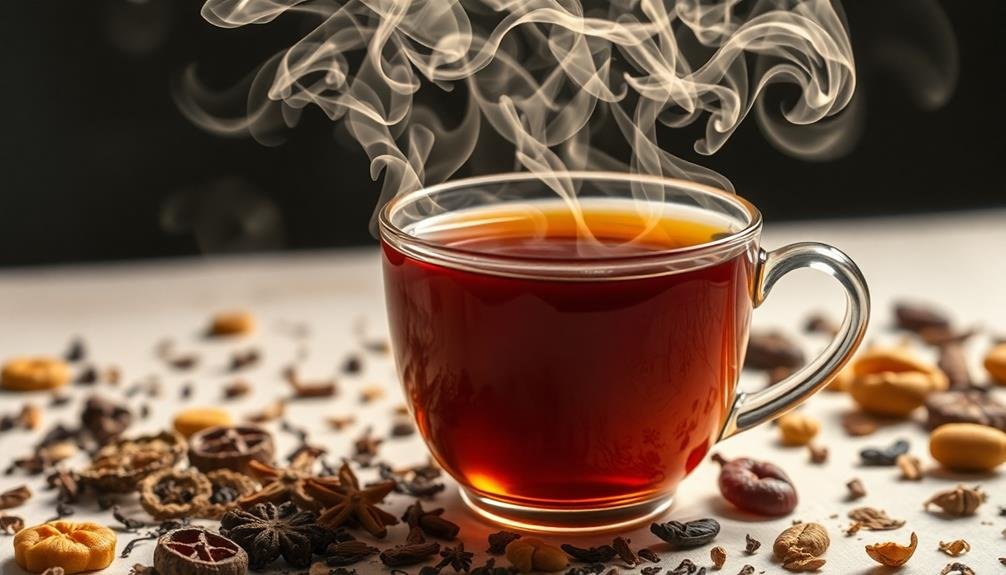
Artful layering of ingredients is key to creating complex and intriguing bold tea blends. You'll want to start with a strong base tea, such as Assam or Yunnan, to provide a solid foundation.
Then, carefully select complementary ingredients that enhance and build upon the base tea's flavor profile.
Consider these principles when layering ingredients:
- Balance: Combine bold and subtle flavors to create depth without overwhelming the palate
- Contrast: Incorporate ingredients with different taste characteristics to add interest
- Harmony: Guarantee all elements work together cohesively
As you layer ingredients, think about how each addition will interact with the others. Spices like cinnamon or cardamom can add warmth and complexity, while citrus peels can bring brightness and zest.
Dried fruits can contribute sweetness and tartness, while herbs like mint or lemongrass can add freshness and aroma.
Experiment with different ratios and combinations to find the perfect balance. Remember that some ingredients may require longer steeping times than others, so consider how this will affect the overall flavor profile.
Frequently Asked Questions
Can Bold Tea Blends Be Mixed With Coffee for a Unique Flavor Profile?
You can mix bold tea blends with coffee for a unique flavor profile. It's an adventurous combination that can create interesting taste experiences. However, be prepared for strong flavors and caffeine content. Experiment with ratios to find your perfect blend.
How Do Different Water Types Affect the Taste of Bold Tea Blends?
You'll notice that water types greatly impact bold tea blends. Hard water can mute flavors, while soft water enhances them. Filtered water often provides the best balance, allowing you to fully appreciate the tea's complex profile.
Are There Any Health Benefits Specific to Harmonized Bold Tea Blends?
You'll find harmonized bold tea blends offer unique health benefits. They're rich in antioxidants, may boost metabolism, and can support heart health. The combination of flavors can also enhance overall well-being and provide a more satisfying drinking experience.
What Role Does Packaging Play in Preserving the Flavors of Bold Teas?
You'll want to use airtight, opaque packaging to protect bold teas from light, air, and moisture. It's essential to maintain flavor integrity. Choose containers with tight seals and store them in a cool, dark place.
Can Bold Tea Blends Be Used in Cooking or Baking Applications?
You can definitely use bold tea blends in cooking and baking! They'll add unique flavors to your dishes. Try infusing sauces, marinades, or baked goods with strong teas. You'll be surprised by the delicious depth they bring.
In Summary
You've discovered the art of harmonizing bold tea flavors. By experimenting with complementary herbs, balancing with milder teas, and adding citrus notes, you'll create perfectly balanced blends. Don't forget the power of sweeteners and precise steeping techniques. Remember, it's all about layering ingredients for complexity. With these tools in your tea-blending arsenal, you'll craft exquisite, harmonious teas that delight the senses. Keep exploring and refining your blends to find your perfect cup.

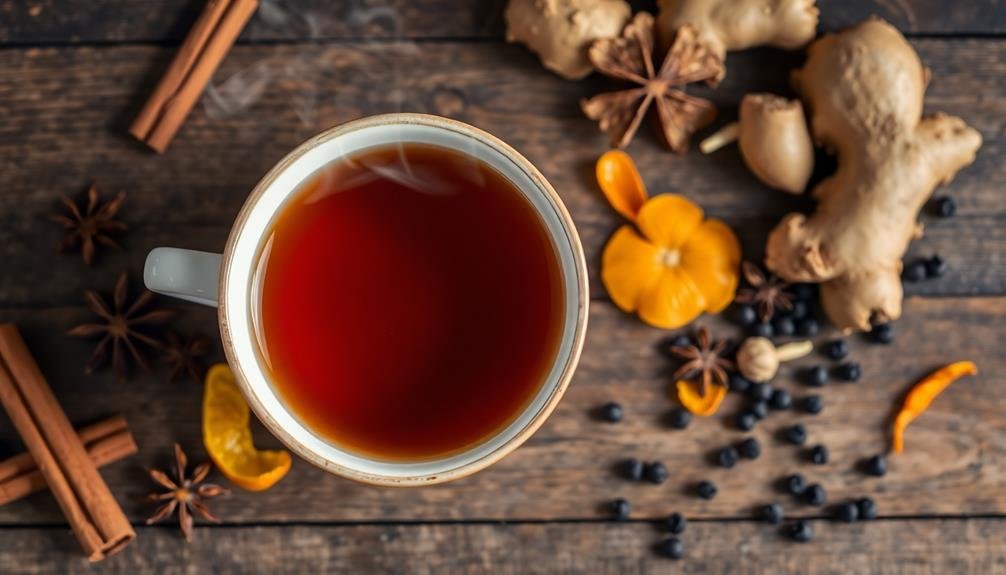
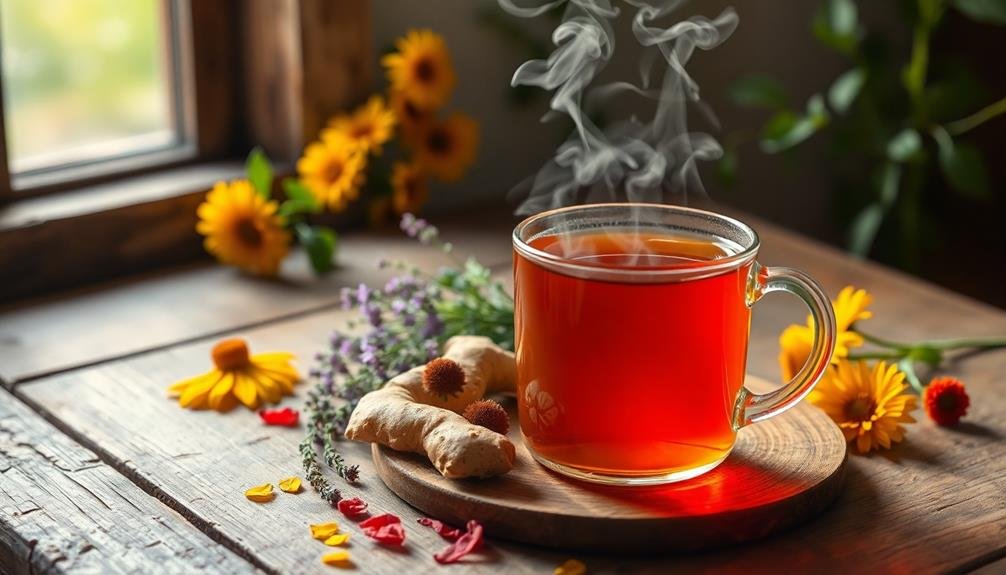
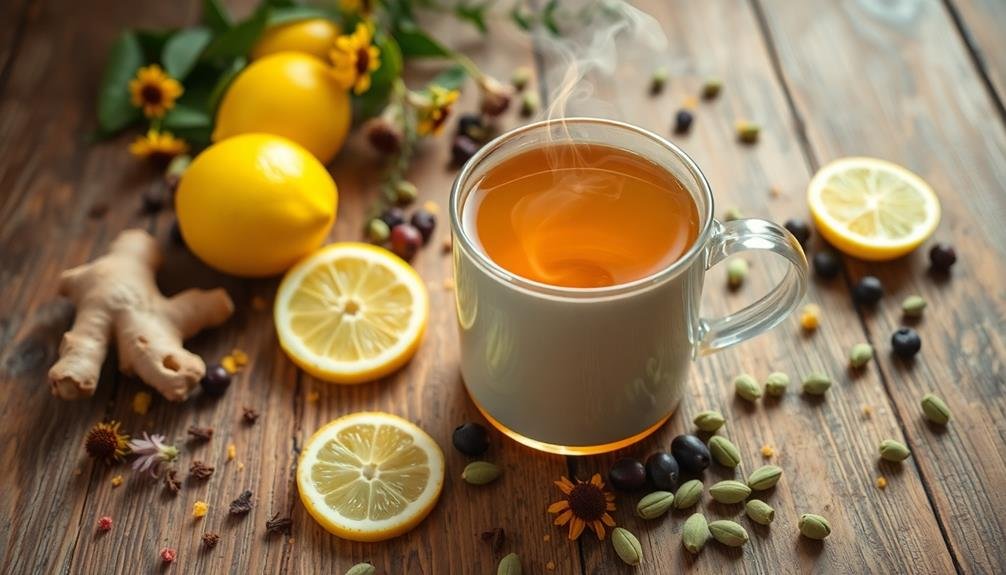
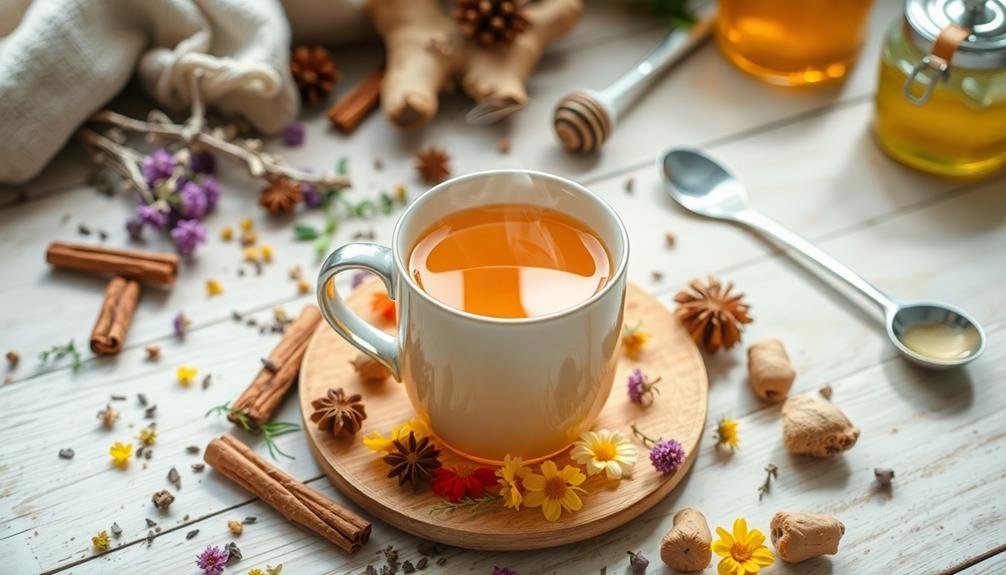
Leave a Reply